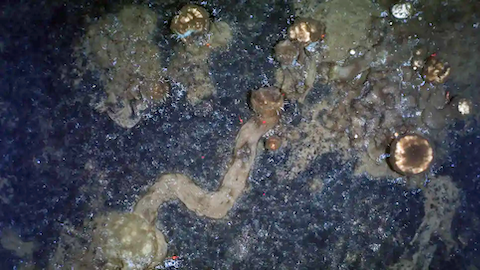
Sponges may look like plants, but they’re animals—some of the longest-lived on Earth, with a few living more than 10,000 years.
They’re also the least evolutionarily advanced creatures on the planet. But new accidental findings may show we’ve underestimated them.
Sponges evolved more than 500 million years ago, flourished through Earth’s great extinction events, and have endured ever since.
Today there are 6,000 known species and new ones being identified regularly.
Sponges were thought to be unresponsive to outside stimuli and, well, very plantlike. But that changed when it was revealed that sponges could move.
Scientists studying undersea vents in one of the least hospitable places on Earth, in the cold blackness a mile beneath Arctic ice, found thousands of sponges living in the warmer water near the thermal vents.
They set up specialized photography to look at vent activity but were amazed to see something else. The sponges were scuttling—very slowly—across the sea floor.
Most of them had left tracks in the mud behind them, filled with protein crystals called spicules.
Sponges have no muscles or apparent method of mobility. Why and how they do it is still a mystery. But this is a key part of science: looking for one thing and finding something else altogether new.
Perhaps future expeditions will help us understand these and other hidden talents of sponges.
Background
Synopsis: Sponges are used in most households, but they are simply imitations of natural sponges that have been used for thousands of years for cleaning and bathing. Natural sponges are primitive animals that may seem immobile, but photos from a recent Arctic expedition show that slowly but surely they make tracks on the seafloor as they move.
- When you think of sponges, you may think of the synthetic ones for washing dishes.
- Many are made of colorful fossil-fuel-based plastics and polyester foam with an abrasive polyurethane side. These last thousands of years in landfills.
- Some are vegetal cellulose made from natural regenerated wood pulp and cotton fibers that are heated and extruded into a foamy biodegradable sponge.
- But these didn’t exist before the 1940s. Humans have been using natural sponges for bathing and cleaning for more than 3,000 years—even Aristotle provided recommendations about their selection and use.
- Natural sponges (phylum Porifera) are primitive animals that evolved more than 600 million years ago in the Ediacaran Period of the Precambrian Eon before the Cambrian explosion of life.
- After the first of Earth’s great extinctions (ED-004), 444 million years ago in the Ordovician Period, sponges flourished, occupying open ecological niches.
- Today there are more than 6,000 species of sponges, most of which live in sea water, although around 100 species live in fresh water. New species are still being identified.
- Sponges may be the least evolutionarily advanced animals on Earth.
- Most sponges are rigid vase-like structures that are supported by a mesh of silica or calcium carbonate spicules surrounded by a protein called spongin.
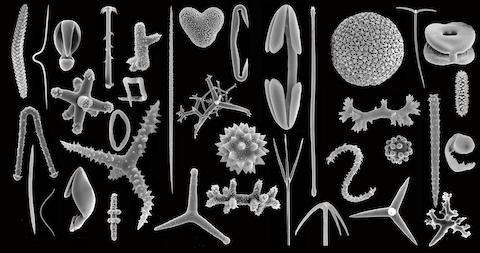
Scanning electron micrograph images of a variety of sponge spicules (not to scale) ranging in size from 0.01 to 1 mm. Credit: Rob W. M. Van Soest et al., CC BY 2.5 <https://creativecommons.org/licenses/by/2.5>, via Wikimedia Commons - Sponges are typically classified based on the size, shape and composition of their spicules.
- Sponges may seem more like plants than animals.
- Their larvae are free swimming, but adult sponges anchor themselves to the seafloor substrate in calm water environments ranging from intertidal zones to the deep sea.
- Sponges may reproduce by budding—broken pieces can grow into a new sponge, like some plants.
- They don’t have a nervous system so they don’t move when touched.
- However, unlike plants, sponges can’t make their own food. Sponges are carnivorous, consuming tiny crustaceans, and, as filter feeders, consuming microscopic organisms that live in seawater.
- Spongin is a type of collagen, just like the tendons, ligaments, and skin of other animals, and DNA also confirms sponges come from the animal kingdom.
- Porifera is Latin for pore-bearer.
- Sponges have many pores on their surfaces through which they draw water, nutrients and microbes using hair-like flagella to create currents. Waste is expelled through the center of the sponge.
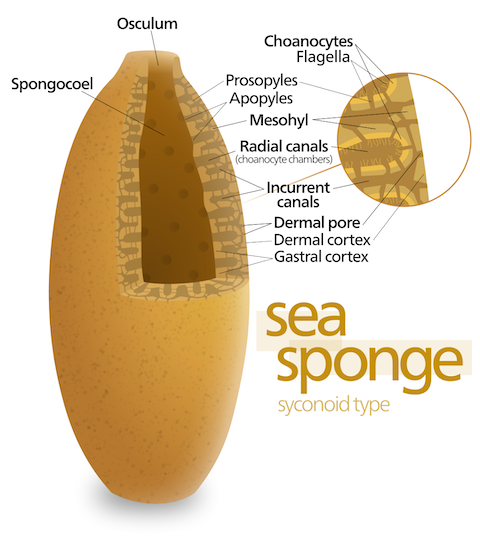
Diagram of a vase-shaped syconoid sponge. Credit: Kelvinsong, CC BY-SA 3.0 <https://creativecommons.org/licenses/by-sa/3.0>, via Wikimedia Commons - Sponges don’t have tissue, muscle, or organs like most multi-celled animals, so necessary functions, like digestion, reproduction and waste disposal are performed by specialized cells.
- Sponges are multicellular colonial animals, but the cells are so loosely connected that if placed in a blender they will simply reform into another sponge.
- Different species of sponges range from just 0.5 in (1 cm) to 11 ft (3.35 m) when full grown. In addition to vase shapes, some sponges may look like crusts and others may be branched.
- Sponges have many pores on their surfaces through which they draw water, nutrients and microbes using hair-like flagella to create currents. Waste is expelled through the center of the sponge.
- Certain individual sponges have been aged at hundreds to thousands of years old.
- One deep-sea sponge of the species Monorhaphis chuni has been identified as one of the oldest animals on Earth at around 11,000 years old.
- Recently scientists made another amazing discovery about sponges in the Arctic Ocean—they can move!
- Since sponges attach themselves to the seafloor and have no muscles to enable locomotion, many observers assumed they would be immobile, but 2016 seafloor photography using sled-mounted cameras towed behind the research vessel Polarstern tells a different story.
- The photos were taken near the Langseth Ridge, a chain of marine seamounts a mile below the Arctic ice, where the photographs record a dense community of more than 10,000 sponges.
- In the 70% of photos showing live sponges, trails cover the seafloor in the wake of sponges ranging in size from 0.5 in (1 cm) to around 3 ft (1 m).
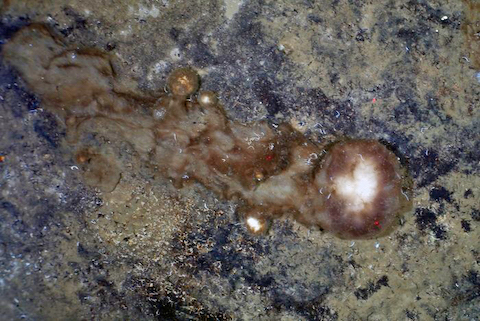
Sponge trails on the seafloor. Credit: AWI OFOBS team, PS101 - The trails move uphill and change directions abruptly.
- Juvenile sponges inhabit many of the trails.
- The trails are composed of toy jack-like sponge spicules that researchers believe were left behind as the sponges slowly moved across the seafloor.
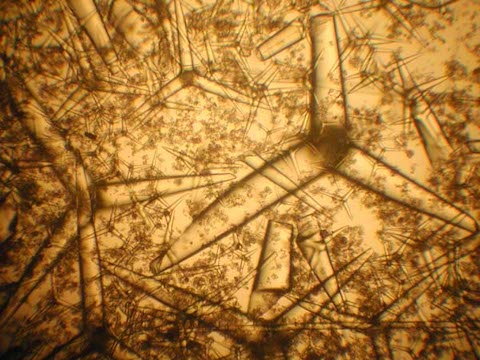
Microscopic spicules from a pachastrellid sponge look like toy jacks. Credit: NOAA - Sponge movement previously observed in lab settings in response to external stimuli has been by very slow expansion and contraction of their bodies at rates of a few millimeters per month.
- Biologists speculate that the sponges move in search of food, better locations, or to give their offspring more room to thrive—some suggest the trails provide a nutrition source for juveniles.
- Researchers don’t know if the movements are constant or sporadic, but it is now clear that these ancient animals are able to react to external stimuli—in what seems like geological time.

